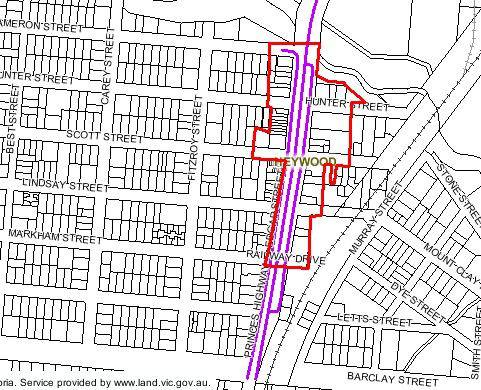| Back to search results » | Back to search page » |
|
HEYWOOD TOWNSHIP PRECINCT
LocationEDGAR STREET, and HUNTER STREET, and SCOTT STREET, HEYWOOD, GLENELG SHIRE LevelRecommended for Heritage Overlay |
|
Statement of Significance
What is Significant?
Heywood is a small town, located on the Princes Highway where it crosses the Fitzroy River about 25kms due north of Portland and the coast. It is arguably one of the oldest inland settlements in Victoria beginning, as was usual, with a public house located at a ford which was soon superseded by a bridge built by the first publican. The crossing was critical for access to the vast pastoral holdings to the north-west and to the north-east. There was an extra impetus to its foundation from the nearby Mounted Police Barracks and Native Police Barracks. Although small, the town survives as a service centre for the immediate district and as a junction of the Princes and Henty Highways. Heywood experienced boom in the post war years as a result of the increase in the price of wool. As a result, many of the commercial buildings in Edgar Street were modernised with new facades, or demolished for new buildings to be erected. Edgar Street has long been the main thoroughfare of the township, and follows the original route from Portland to Dartmoor and eventually Adelaide in one direction and to Hamilton in the other. Most of the buildings in the centre of the town are commercial and civic and all but one are single-storey. The wide main street is laid out as a grand boulevard with median plantings. It is dominated on the east side by the former Gothic revival Heywood State School and on the west by the two-storey Heywood Hotel. An obelisk on the eastern median strip on axis with the school commemorates those who served and fell in World War One and Two. The settlement started officially in 1841, when a licence was granted to the Bush Inn which was established by David Edgar, an important squatter as well as a publican. The town has been primarily a service centre for the surrounding pastoral properties, and later as a timber town. The contributory heritage places are mainly clustered between Cameron Street and Scott Street. Although much has been lost over the years, the precinct retains a fair degree of integrity and is in good condition.
How is it significant?
The HeywoodTownship Precinct is of historical, social and architectural significance to the Glenelg Shire.
Why is it significant?
The HeywoodTownship Precinct is of historic significance as a township dating from the late 1830s, as one of the chain of small settlements between Portland, Hamilton and Penola and as the focus for the pastoral properties surrounding the township from the early 1840s onward. It is of social significance as the focus for the community's education and recreation, roles that continue to the present. The architectural significance of the town lies in the limited number of buildings constructed from local materials over a long period of time, particularly the former Heywood State School and the Heywood Hotel. Of further significance is the collection of post World War Two buildings in the commercial centre, which represent the prosperity in the township and surrounding district in the 1950s and 60s as a result of the woolboom.
Group
Urban Area
Category
Mixed Use Precinct




